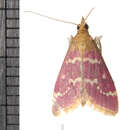Conservation Status
provided by University of Alberta Museums
Uncommon due to habitat loss from agriculture.
- license
- cc-by-nc
- copyright
- University of Alberta Museums
Cyclicity
provided by University of Alberta Museums
Late June to mid July.
- license
- cc-by-nc
- copyright
- University of Alberta Museums
Distribution
provided by University of Alberta Museums
Known from Ontario west to British Columbia, south to Texas and the Carolinas (Munroe 1976). The Type Locality is simply given at North America. In Alberta, it has been reported from Areas 1 (Cypress Hills), 6 and 18 (Waterton) by Bowman (1951). It is also known from Dry Island Buffalo Jump Provincial Park, the Lowden Springs Conservation Area, Nevis, Red Deer, and Taber.
- license
- cc-by-nc
- copyright
- University of Alberta Museums
General Description
provided by University of Alberta Museums
A pretty moth with bright pink or purplish forewings and a wingspan of 18-22 mm. The forewings above have narrow, jagged, white AM and PM lines, and there is a white discal spot. The hind wings above are light brown and have a weak PM line. The labial palps point forward. The genitalia are described in Munroe (1976).
- license
- cc-by-nc
- copyright
- University of Alberta Museums
Habitat
provided by University of Alberta Museums
Areas of native Aspen Parkland and grassland
coulees where Monarda fistulosa occurs.
- license
- cc-by-nc
- copyright
- University of Alberta Museums
Life Cycle
provided by University of Alberta Museums
Details unknown. Adults come to light.
- license
- cc-by-nc
- copyright
- University of Alberta Museums
Trophic Strategy
provided by University of Alberta Museums
The larvae feed on species of Monarda (Munroe 1976). Monarda fistulosa occurs in Alberta.
- license
- cc-by-nc
- copyright
- University of Alberta Museums
Pyrausta signatalis
provided by wikipedia EN
- license
- cc-by-sa-3.0
- copyright
- Wikipedia authors and editors
Pyrausta signatalis: Brief Summary
provided by wikipedia EN
Pyrausta signatalis, the raspberry pyrausta moth, is a moth in the family Crambidae. It was described by Francis Walker in 1866.
- license
- cc-by-sa-3.0
- copyright
- Wikipedia authors and editors

